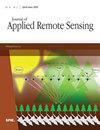Spatiotemporal fusion convolutional neural network: tropical cyclone intensity estimation from multisource remote sensing images
IF 1.4
4区 地球科学
Q4 ENVIRONMENTAL SCIENCES
引用次数: 0
Abstract
Utilizing multisource remote sensing images to accurately estimate tropical cyclone (TC) intensity is crucial and challenging. Traditional approaches rely on a single image for intensity estimation and lack the capability to perceive dynamic spatiotemporal information. Meanwhile, many existing deep learning methods sample from a time series of fixed length and depend on computation-intensive 3D feature extraction modules, limiting the model’s flexibility and scalability. By organically linking the genesis and dissipation mechanisms of a TC with computer vision techniques, we introduce a spatiotemporal fusion convolutional neural network that integrates three distinct improvement approaches. First, an a priori aware nonparametric fusion module is introduced to effectively fuse key features from multisource remote sensing data. Second, we design a scale-aware contraction–expansion module. This module effectively captures detailed features of the TC by connecting information from different scales through a weighted and up-sampling method. Finally, we propose a 1D–2D conditional sampling training method that balances single-step regression (for short sequences) and latent-variable-based temporal modeling (for long sequences) to achieve flexible spatiotemporal feature perception, thereby avoiding the data scale constraint imposed by fixed sequence lengths. Through qualitative and quantitative experimental comparisons, the proposed spatiotemporal fusion convolutional neural network achieved a root-mean-square error of 8.89 kt, marking a 29.7% improvement over the advanced Dvorak technique, and its efficacy in actual TC case analyses indicates its practical viability and potential for broader applications.时空融合卷积神经网络:从多源遥感图像估算热带气旋强度
利用多源遥感图像准确估算热带气旋(TC)强度至关重要,也极具挑战性。传统方法依赖单一图像进行强度估算,缺乏感知动态时空信息的能力。同时,许多现有的深度学习方法都是从固定长度的时间序列中采样,并依赖于计算密集型的三维特征提取模块,限制了模型的灵活性和可扩展性。通过将时空旅行的成因和消散机制与计算机视觉技术有机地联系起来,我们引入了一种时空融合卷积神经网络,该网络集成了三种不同的改进方法。首先,我们引入了先验感知非参数融合模块,以有效融合多源遥感数据的关键特征。其次,我们设计了一个规模感知的收缩-扩展模块。该模块通过加权和向上采样的方法将不同尺度的信息连接起来,从而有效捕捉到热带气旋的细节特征。最后,我们提出了一种 1D-2D 条件采样训练方法,该方法兼顾了单步回归(适用于短序列)和基于潜变量的时间建模(适用于长序列),实现了灵活的时空特征感知,从而避免了固定序列长度带来的数据尺度限制。通过定性和定量实验比较,所提出的时空融合卷积神经网络的均方根误差为 8.89 kt,比先进的 Dvorak 技术提高了 29.7%,其在实际 TC 案例分析中的有效性表明了其实际可行性和更广泛的应用潜力。
本文章由计算机程序翻译,如有差异,请以英文原文为准。
求助全文
约1分钟内获得全文
求助全文
来源期刊

Journal of Applied Remote Sensing
环境科学-成像科学与照相技术
CiteScore
3.40
自引率
11.80%
发文量
194
审稿时长
3 months
期刊介绍:
The Journal of Applied Remote Sensing is a peer-reviewed journal that optimizes the communication of concepts, information, and progress among the remote sensing community.
 求助内容:
求助内容: 应助结果提醒方式:
应助结果提醒方式:


